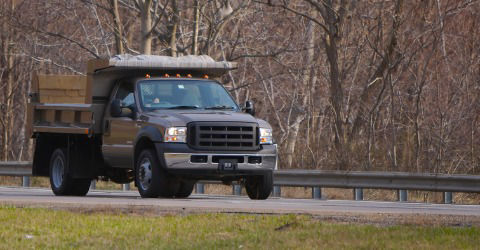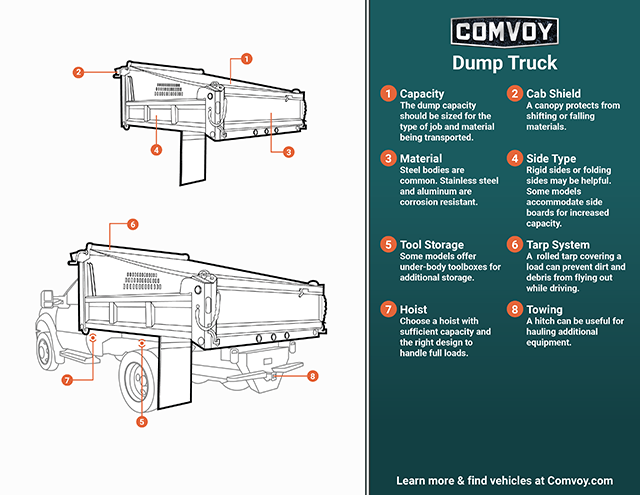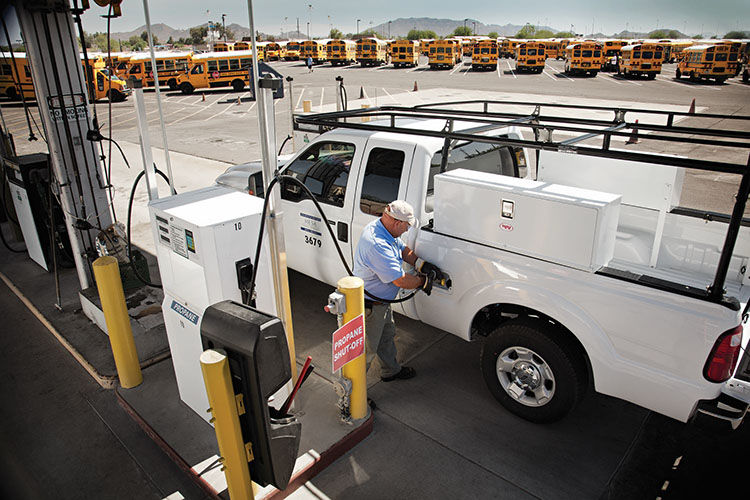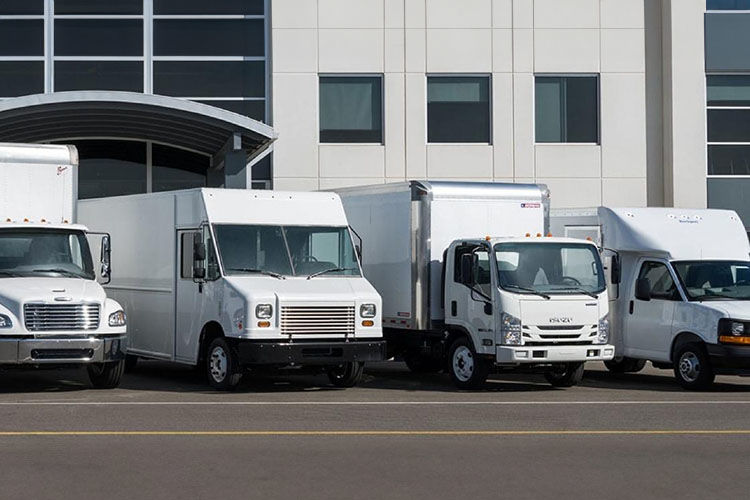Dump Truck: Hauling and Delivering
 (1).png)
 (1).png)
Dump Truck: Hauling and Delivering
The dump truck is a classic commercial vehicle, with long-standing use and renown - and for good reason. Ideal for hauling and delivering heavy loads of loam, mulch, gravel, rip-rap, asphalt, logs, and heavy stone, the dump truck is the optimal pack for any fleet that deals with loose materials on a constant basis.
Capacity
The amount of material your dump truck needs to haul, from both a weight perspective and an overall measurement perspective, should be the first stop in any buyer’s purchase process. Dump trucks, though fairly easy to recognize on the street, vary in body sizes and useful interior yardage. Body sizes typically carry between two and eight yards, but larger mid and full-size models can support up to thirty-three yards or greater. When considering the size of the body you’ll be supporting, it’s also prudent to identify the weight per cubic yard, for each material of your choosing. Each manufacturer model will vary in its payload capacity and dimensions, making it a prudent step to first identify the size and weight of each load that you plan to deliver, before visiting the dealer.
Cab Shield
A cab shield is an extended metal covering which sits just behind the rear windshield, safeguarding your cab against materials moving about in the cargo bay. Some cab shields also include roof coverage, with two joined pieces of metal fully covering both the roof and rear windshield, featuring a grated mesh behind the rear windshield for improving visibility. The cab shield is built from the same material selected for your dump body and serves as a barrier between the dump truck cab and your material. The cab shield is a simple countermeasure to hard stops, traffic accidents, and shifting materials - all of which can result in needlessly injured employees and a damaged vehicle.
Material
The dump trucks of yesteryear were predominantly built with strength and durability in mind, with some consideration for how upfit weight would impact fuel efficiency and payload capacity. Steel was, and still is, a common material used in the production of dump bodies, due to how strong and cost-effective it is. That being said, steel dump bodies also add a fair amount of weight, resulting in an overall reduction in payload capacity before any working materials have been added.
Aluminum alloys, one of the previously-questionable options in terms of dump truck body durability, have since achieved high regard in commercial vehicle manufacturing. With modern enhancements like heat-treating, aluminum alloys now boast comparable strength to steel, with the reduced weight that aluminum brings. The lighter weight build results in increased fuel efficiency distributes more weight capacity to the payload and maintains form in conditions where heavy materials are used. Aluminum alloys also offer better corrosion resistance than steel.
Click Here for More Information
Side Type
When using the dump truck, there are often times when the desired function of the truck will change. One workday may require a rigid delivery of loose material into one location from the back of the body, where others may require the ability to dump material off to the side of the dump truck. Fortunately, both rigid-side and drop-side dump bodies are available in the modern dump truck.
A rigid-side dump body is perfect for the operation that seldom changes. You can load up the materials, drive off, and unload without the worry of securing drop-side metal panels. Capable of supporting additional side-panels for greater side height, the rigid-side dump body - though restricted in form - is flexible in function. On the other hand, the ability to change the function of your truck on a whim is an incredibly powerful feature of the drop-side or fold-side dump truck body. The drop-side dump truck comes with a series of metal side panels, which lock into place and can be dropped down for easy access to either side of the dump truck bed.
Tool Storage
Specific dump truck models support side, underbody, and rear-cab toolbox installations, providing secure tool storage without skimping on valuable cargo space.
Tarp System
A common problem in the dump truck body is the likelihood of movement and wind shifting loose material out of the truck bed and into traffic behind you. The addition of a tarp system ensures an affordable, lightweight seal to your body, and effectively keeps product within the dump truck bed. Ty pically made from canvas, mesh, or vinyl material, a tarp system is joined to a steel or aluminum cross-bar located behind the rear windshield and above the dump body. Available in both manual and automatic configurations, the tarp system is supported by a series of support arms on either side of the dump body, ensuring that your product stays put beneath an aerodynamic cover.
pically made from canvas, mesh, or vinyl material, a tarp system is joined to a steel or aluminum cross-bar located behind the rear windshield and above the dump body. Available in both manual and automatic configurations, the tarp system is supported by a series of support arms on either side of the dump body, ensuring that your product stays put beneath an aerodynamic cover.
Hoist
What is a dump truck without a suitable hoist, capable of lifting and dumping your material where it needs to go? Most hoists will line into your vehicle’s electrical system, but some may require their own power sources in order to operate at optimum levels. These hoists typically include an angled hydraulic, secured to both the dump body and the dump truck chassis, exerting pressure until the proper dump angle is achieved.
In addition to the single-angle hoist option, there are some hoists which allow you to lift your dump body in multiple directions. These dump truck hoists pair well with the drop-side dump bodies, as they lift in both vertical and horizontal directions, utilizing both sides of the dump body. The multi-directional function of the dump body makes it simple to dump in locations which require specific delivery, without having to put your truck through the 3+ point-turn treatment.
Towing
Towing capacity is also an often-overlooked aspect of the dump truck, due to the powerful and efficient features and accessories that the dump truck body offers. When considering a dump truck body that can handle your towing requirements, it is important to identify what equipment you’ll be towing, the type of trailer and hitch required, and how much the dump body impacts your gross vehicle weight rating. Major manufacturers post detailed towing information on their websites, and it’s a good idea to review the literature of each model before ultimately deciding on your dump body of choice.
Reviewing the technical information of the dump truck in question will help to maintain your manufacturer warranty, avoid costly damage, and keep your dump truck running long after purchase.
Published on: January 02, 2019 Work Truck Solutions and J.D. Power Launch Commercial EV Hub
Work Truck Solutions and J.D. Power Launch Commercial EV Hub The Cost Benefits of Propane Autogas for Commercial Fleets
The Cost Benefits of Propane Autogas for Commercial Fleets Winterizing Commercial Vehicles: Don't Get Caught Out in the Cold!
Winterizing Commercial Vehicles: Don't Get Caught Out in the Cold! Navigating Your Options: Key Tips For Choosing The Right Commercial Vehicle
Navigating Your Options: Key Tips For Choosing The Right Commercial Vehicle Class 2b-3 Commercial Vehicles: How the Industry Can Find the Right Balance Across Supply, Demand, and Emissions Requirements
Class 2b-3 Commercial Vehicles: How the Industry Can Find the Right Balance Across Supply, Demand, and Emissions Requirements






